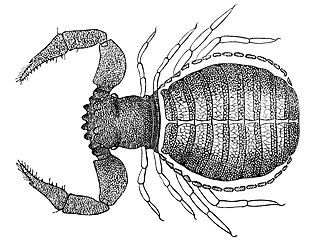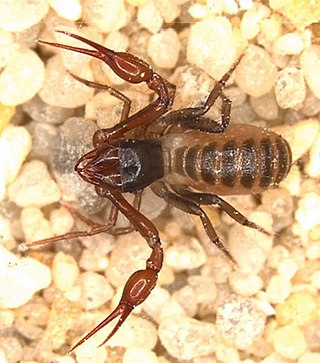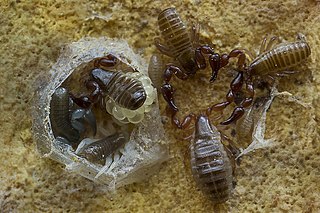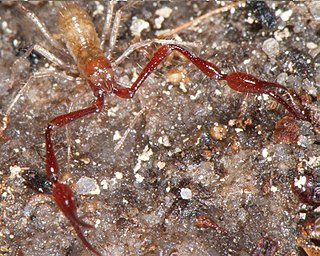September 23 is the 266th day of the year in the Gregorian calendar; 99 days remain until the end of the year.
September 30 is the 273rd day of the year in the Gregorian calendar; 92 days remain until the end of the year.

Feaella is a genus of pseudoscorpions in the family Feaellidae, first described by Edvard Ellingsen in 1906.

Lechytia is a genus of pseudoscorpions in the subfamily Lechytiinae within the family Chthoniidae. It is the sole genus in its subfamily and contains 22 described species from many parts of the world.

Chthoniidae is a family of pseudoscorpions within the superfamily Chthonioidea. The family contains more than 600 species in about 30 genera. Fossil species are known from Baltic, Dominican, and Burmese amber. Chthoniidae now includes the former families Tridenchthoniidae, and Lechytiidae which has been demoted to subfamilies.
Austrochthonius insularis is a species of pseudoscorpions in the family Chthoniidae.
Cryptocheiridium is a genus of pseudoscorpions in the Cheiridiidae family. It was described in 1931 by American arachnologist Joseph Conrad Chamberlin.
Nesidiochernes is a genus of pseudoscorpions in the Chernetidae family. It was described in 1957 by Austrian arachnologist Max Beier.
Austrochthonius is a genus of pseudoscorpions in the family Chthoniidae. It was described in 1929 by American arachnologist Joseph Conrad Chamberlin.

Tyrannochthonius is a genus of pseudoscorpions in the family Chthoniidae. It was described in 1929 by American arachnologist Joseph Conrad Chamberlin.
Sathrochthonius is a genus of pseudoscorpions in the family Chthoniidae. It was described in 1962 by American arachnologist Joseph Conrad Chamberlin.

Pseudotyrannochthonius is a genus of pseudoscorpions in the family Pseudotyrannochthoniidae. It was described in 1930 by Austrian arachnologist Max Beier.

Geogarypus is a genus of pseudoscorpions in the Geogarypidae family. It was described in 1930 by American arachnologist Joseph Conrad Chamberlin. The genus has a cosmopolitan distribution.

Paratemnoides is a genus of pseudoscorpions in the Atemnidae family. It was described in 1991 by Australian arachnologist Mark Harvey.
Americhernes is a genus of pseudoscorpions in the Chernetidae family. It was described in 1976 by American arachnologist William Muchmore.

Withius is a genus of pseudoscorpions in the Withiidae family. It was described in 1911 by English zoologist Harry Wallis Kew. The generic name Withius honours Danish arachnologist Carl Johannes With (1877–1923).
Pseudochiridiidae is a family of pseudoscorpions. It was described in 1923 by American arachnologist Joseph Conrad Chamberlin. Pseudochiridiids are relatively small pseudoscorpions. They are found in plant litter or beneath tree bark. The family was sometimes treated as a subfamily of the Cheiridiidae, but has since been reinstated.
Beierolpium is a genus of pseudoscorpions in the Olpiidae family. It was described in 1976 by French arachnologist Jacqueline Heurtault.

The Gymnobisiidae are a family of pseudoscorpions.








